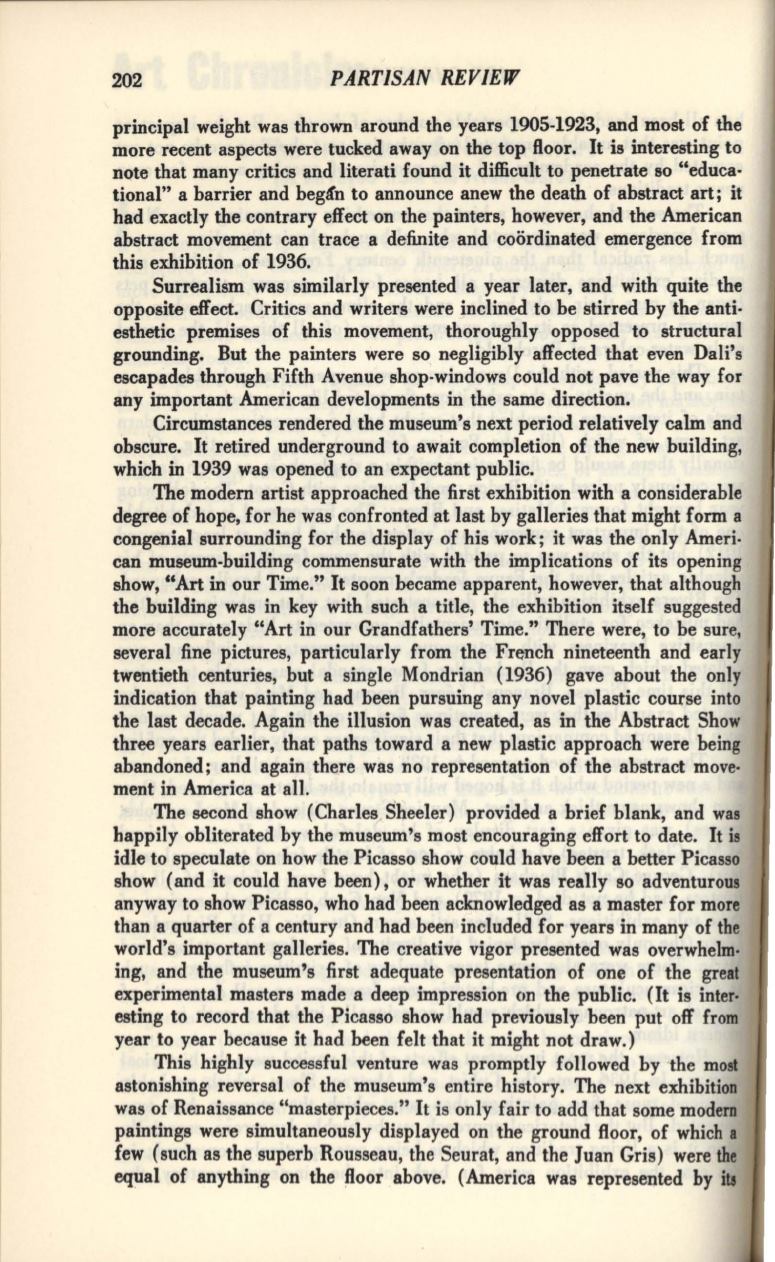
202
PARTISAN REVIEW
principal weight was thrown around the years 1905-1923, and most of the
more recent aspects were tucked away on the top floor_ It is interesting to
note that many critics and literati found it difficult to penetrate so "educa–
tional" a barrier and begtn to announce anew the death of abstract art; it
had exactly the contrary effect on the painters, however, and the American
abstract movement can trace a definite and coordinated emergence from
this exhibition of 1936.
Surrealism was similarly presented a year later, and with quite the
opposite effect. Critics and writers were inclined to be stirred by the anti–
esthetic premises of this movement, thoroughly opposed to structural
grounding. But the painters were so negligibly affected that even Dali's
escapades through Fifth Avenue shop-windows could not pave the way for
any important American developments in the same direction.
Circumstances rendered the museum's next period relatively calm and
obscure. It retired underground to await completion of the new building,
which in 1939 was opened to an expectant public.
The modern artist approached the first exhibition with a considerable
degree of hope, for he was confronted at last by galleries that might form a
congenial surrounding for the display of his work; it was the only Ameri·
can museum-building commensurate with the implications of its opening
show, "Art in our Time." It soon became apparent, however, that although
the building was in key with such a title, the exhibition itself suggested
more accurately "Art in our Grandfathers' Time." There were, to be sure,
several fine pictures, particularly from the French nineteenth and early
twentieth centuries, but a single Mondrian (1936) gave about the only
indication that painting had been pursuing any novel plastic course into
the last decade. Again the illusion was created, as in the Abstract Show
three years earlier, that paths toward a new plastic approach were being
abandoned; and again there was no representation of the abstract move·
ment in America at all.
The second show (Charles Sheeler) provided a brief blank, and was
happily obliterated by the museum's most encouraging effort to date. It is
idle to speculate on how the Picasso show could have been a better Picasso
show (and it could have been), or whether it was really so adventurous
anyway to show Picasso, who had been acknowledged as a master for more
than a quarter of a century and had been included for years in many of the
world's important galleries. The creative vigor presented was overwhelm·
ing, and the museum's first adequate presentation of one of the great
experimental masters made a deep impression on the public. (It is inter·
esting to record that the Picasso show had previously been put off from
year to year because it had been felt that it might not draw.)
This highly successful venture was promptly followed by the most
astonishing reversal of the museum's entire history. The next exhibition
was of Renaissance "masterpieces." It is only fair to add that some modem
paintings were simultaneously displayed on the ground floor, of which
8
few {such as the superb Rousseau, the Seurat, and the Juan Gris} were
the
equal of anything on the floor above. (America was represented by
its


